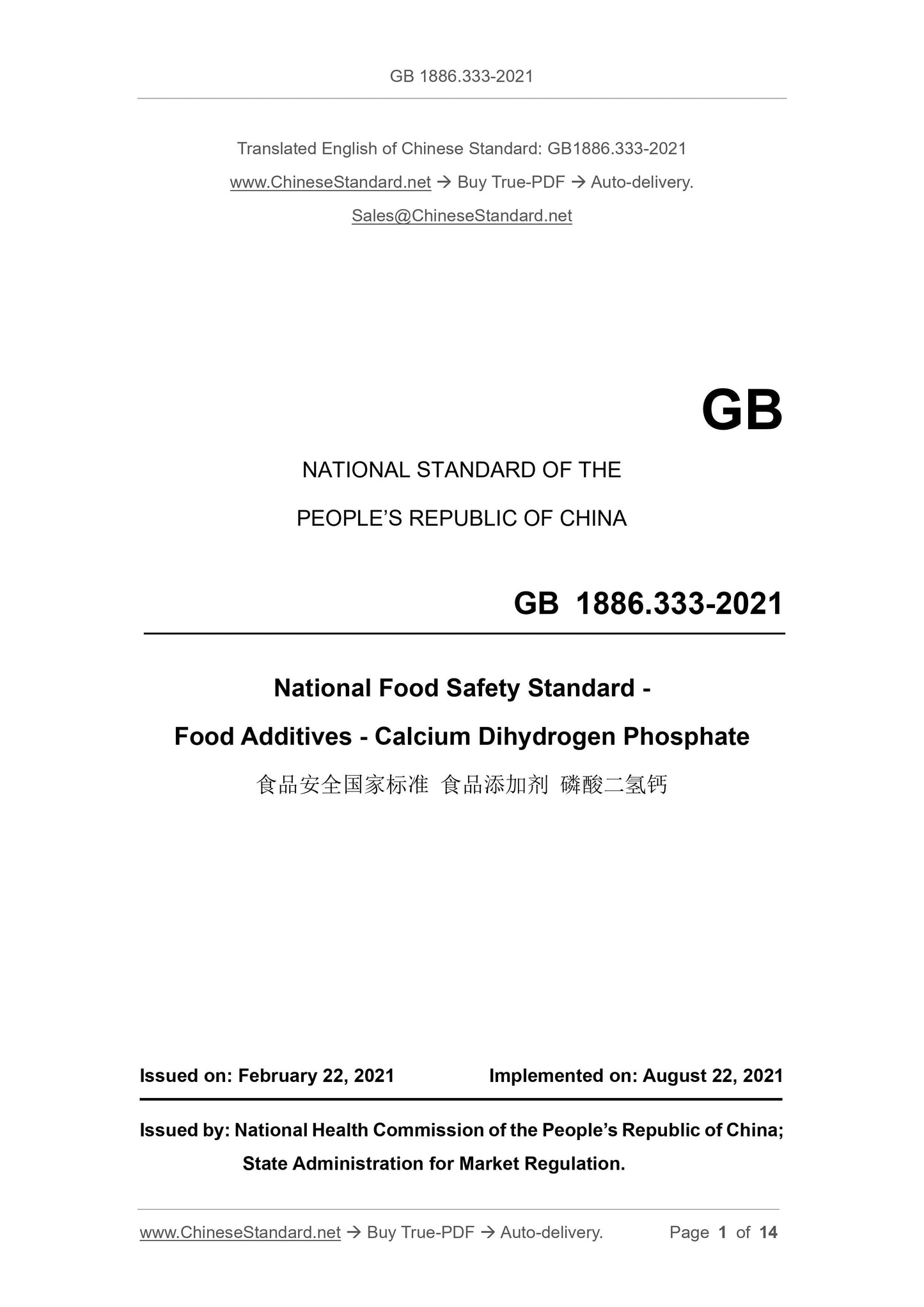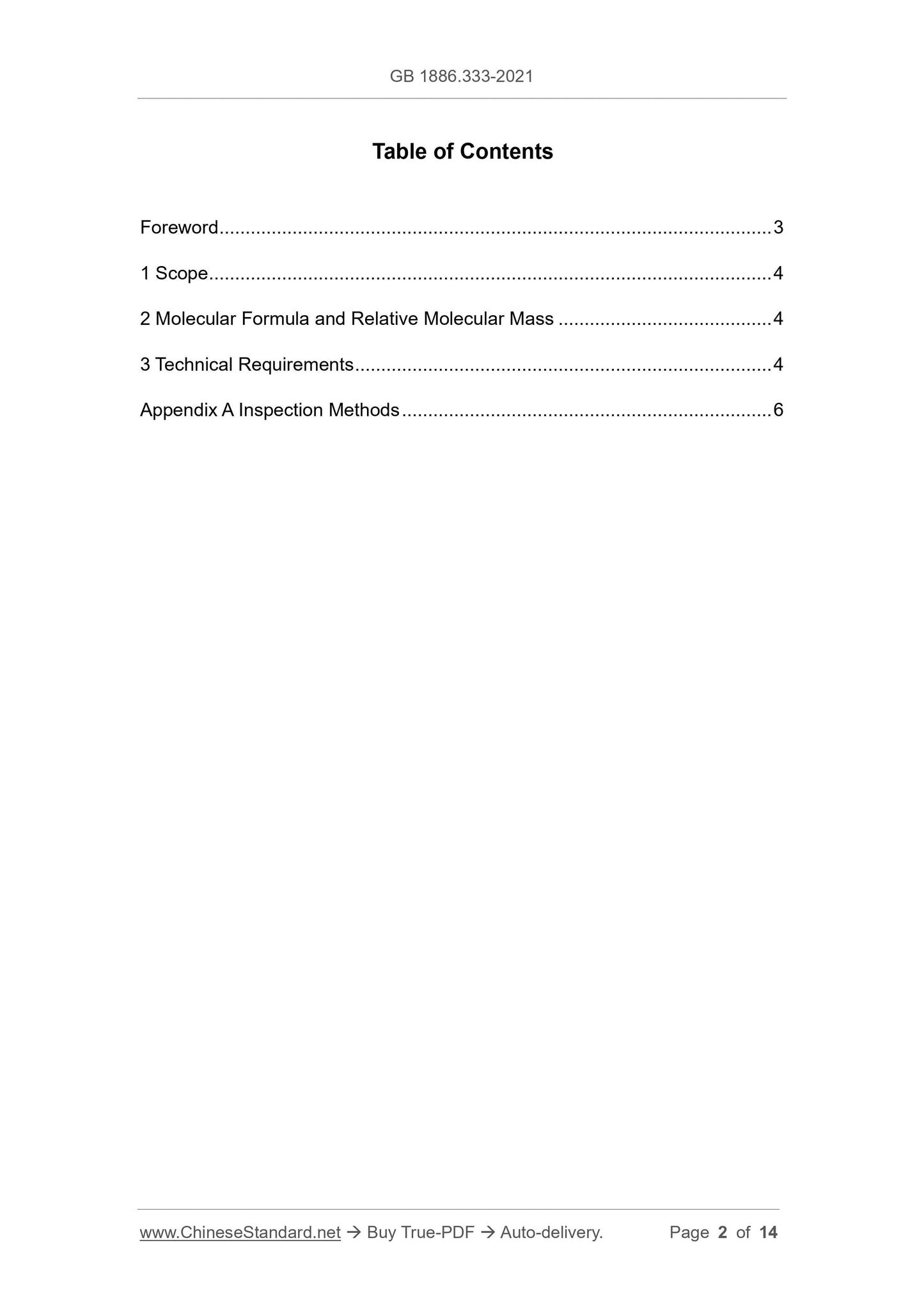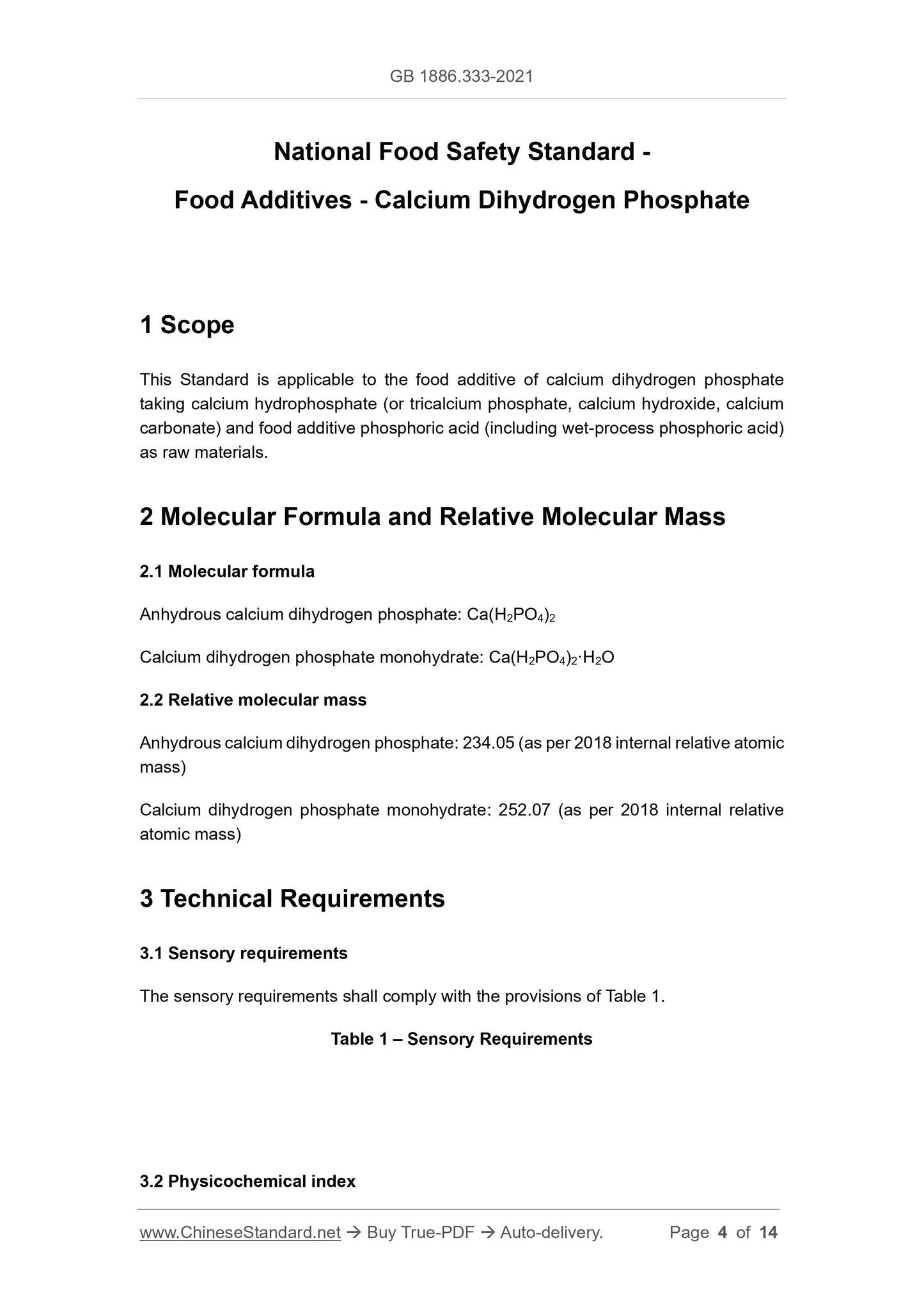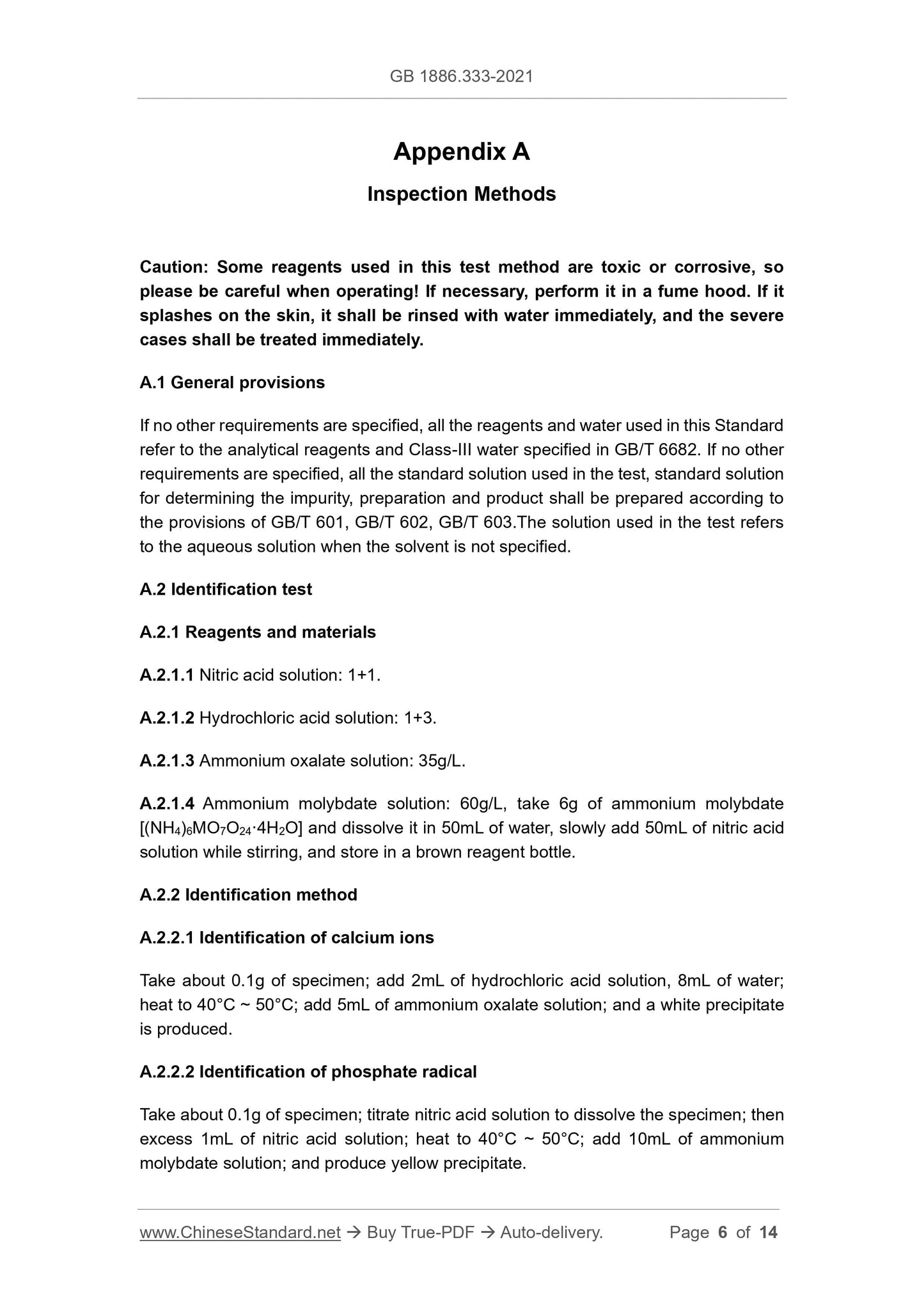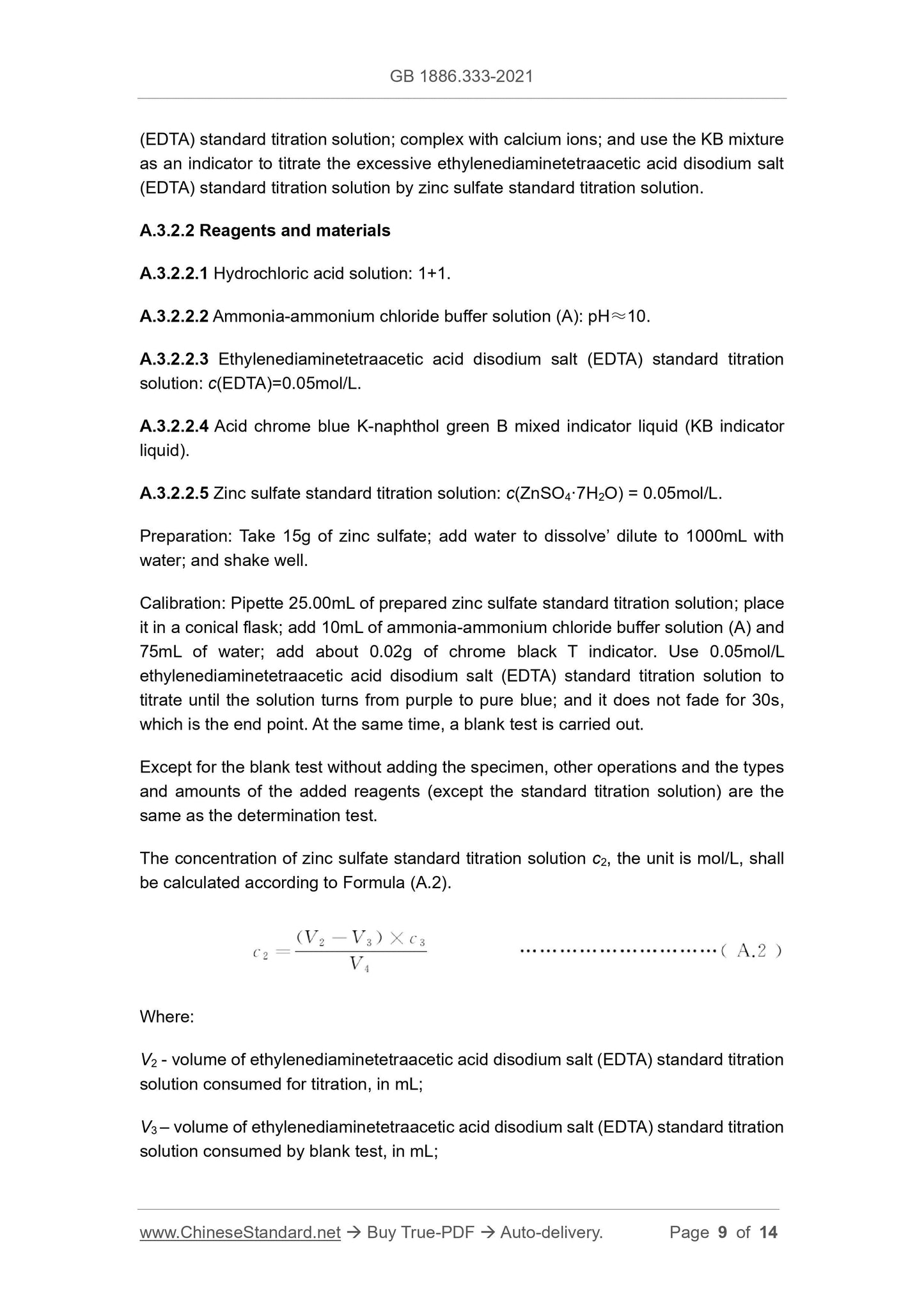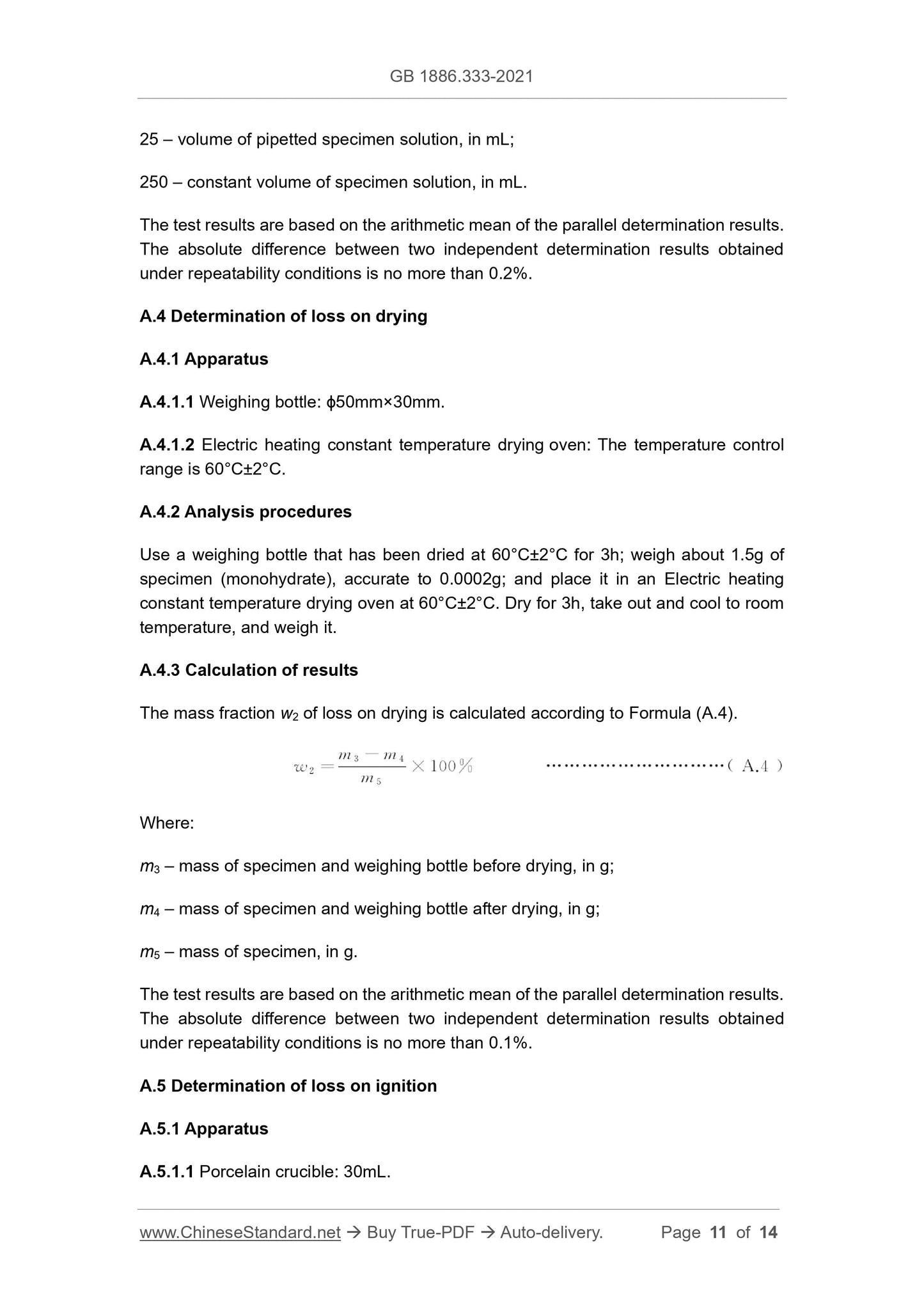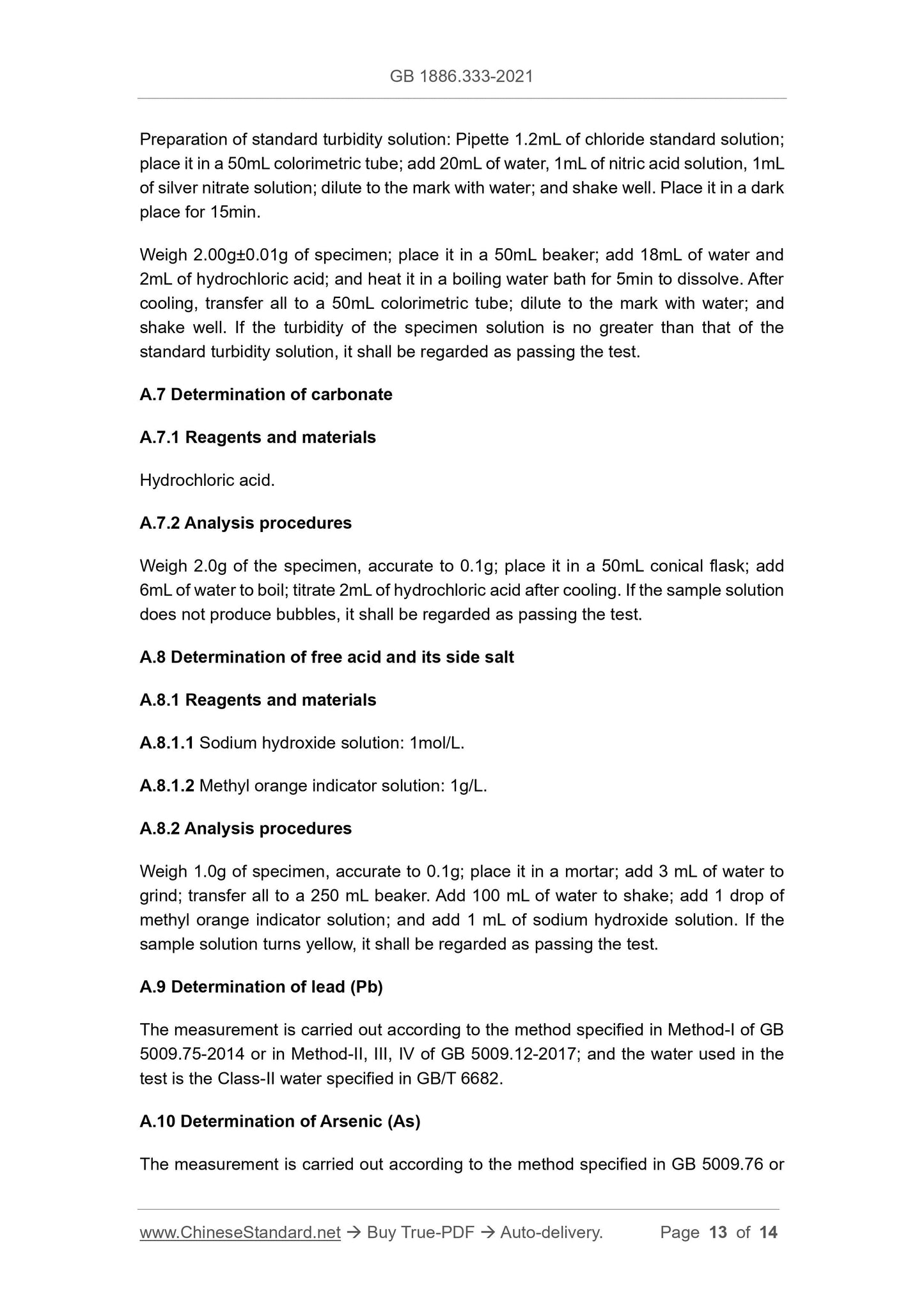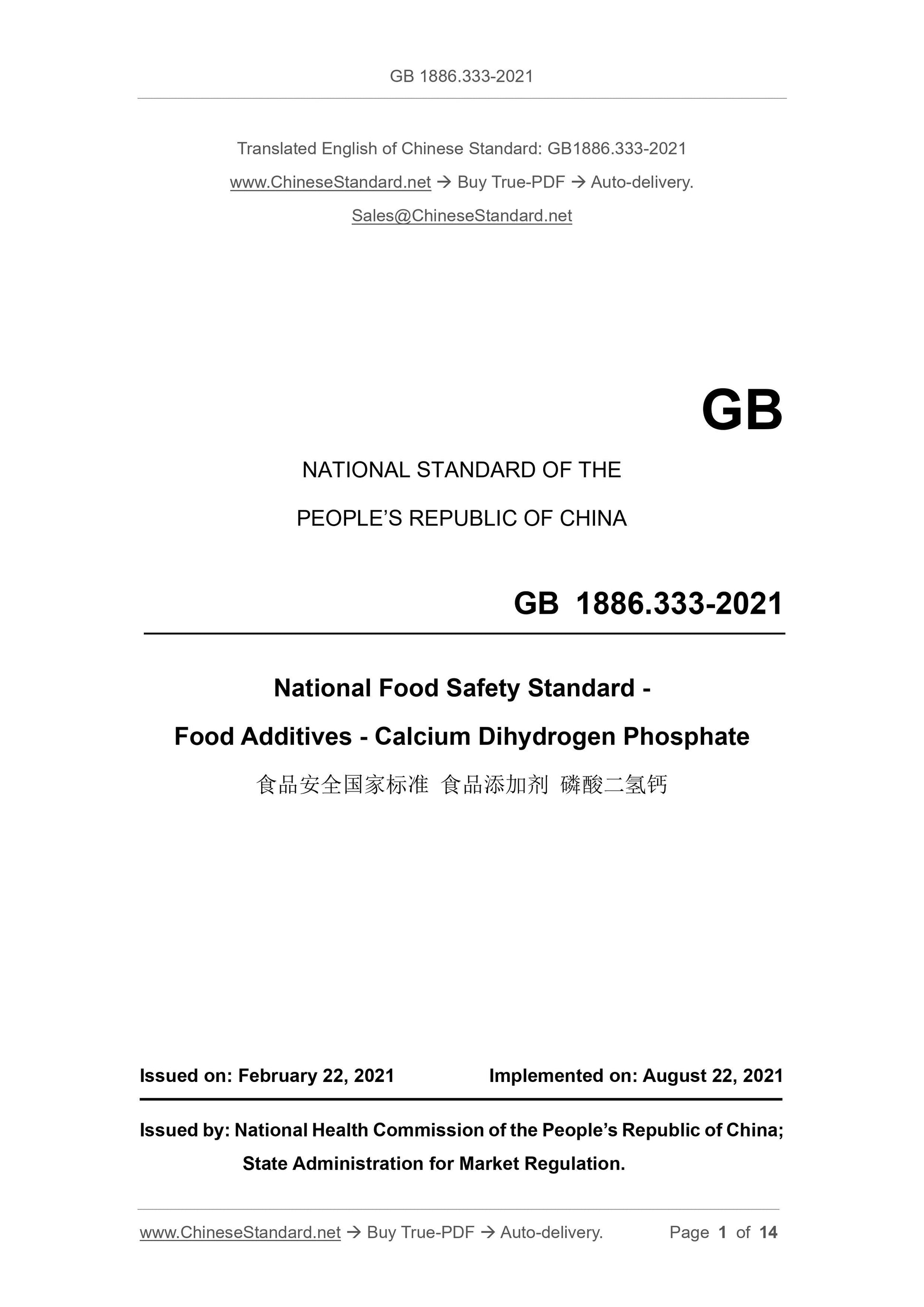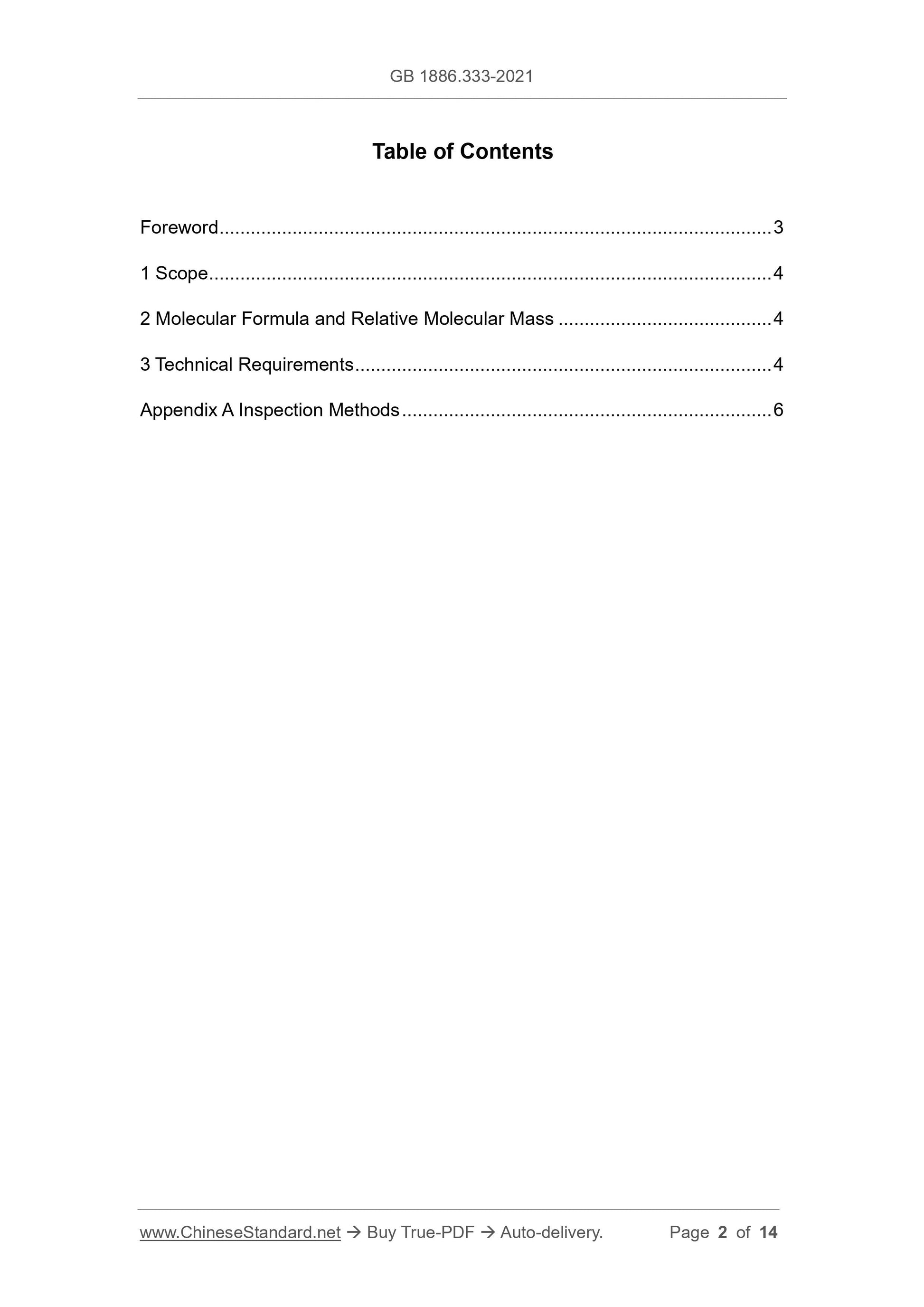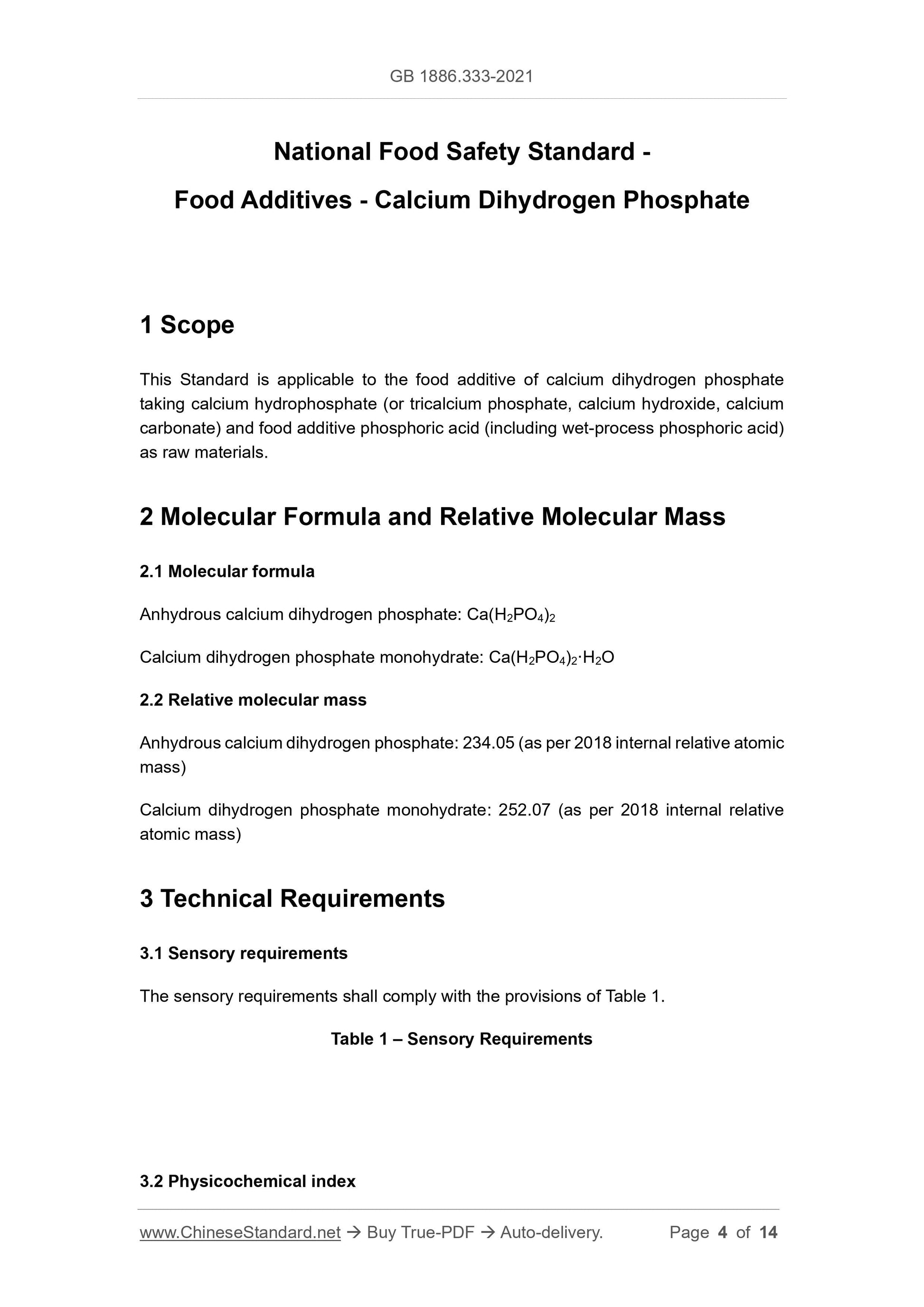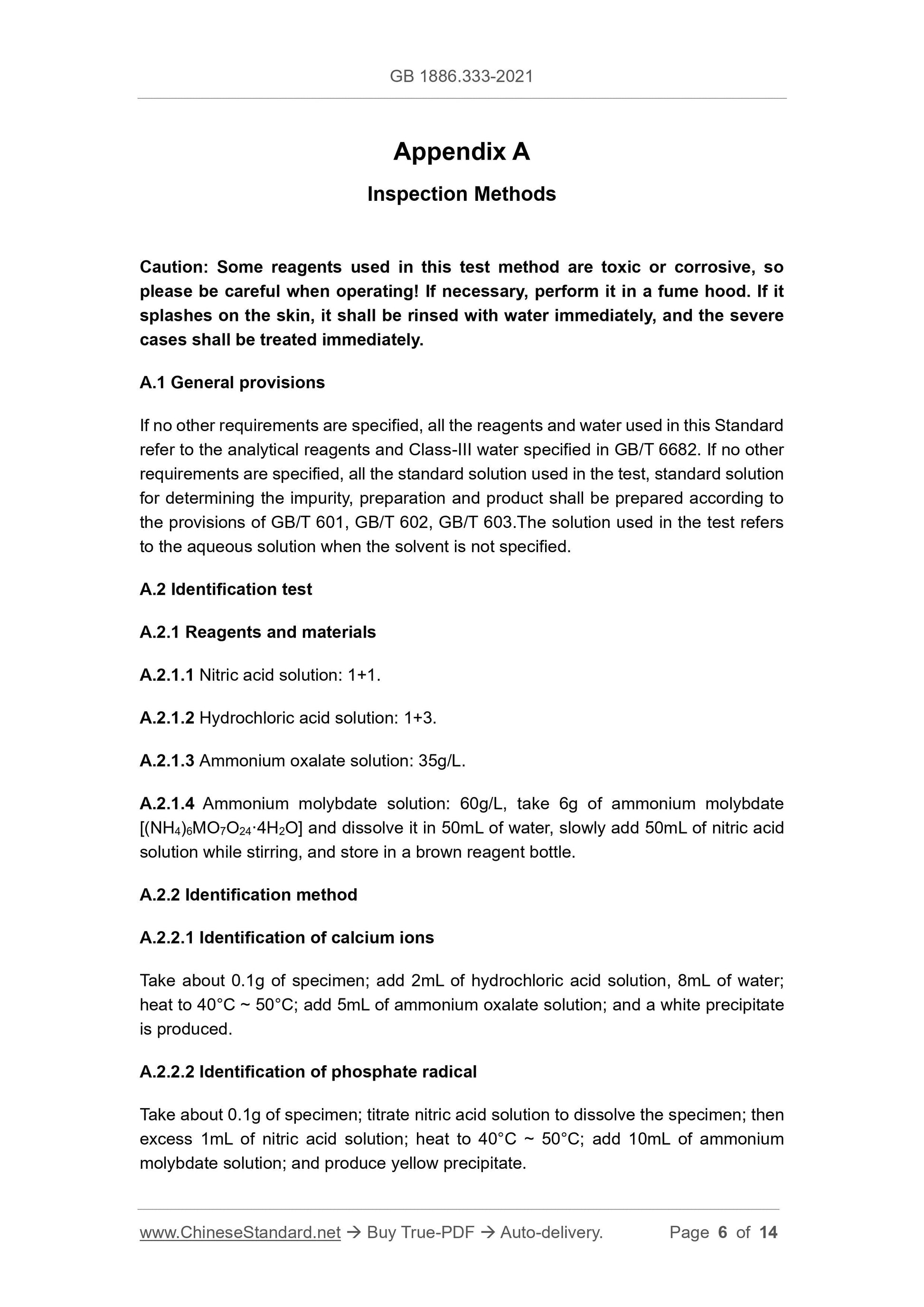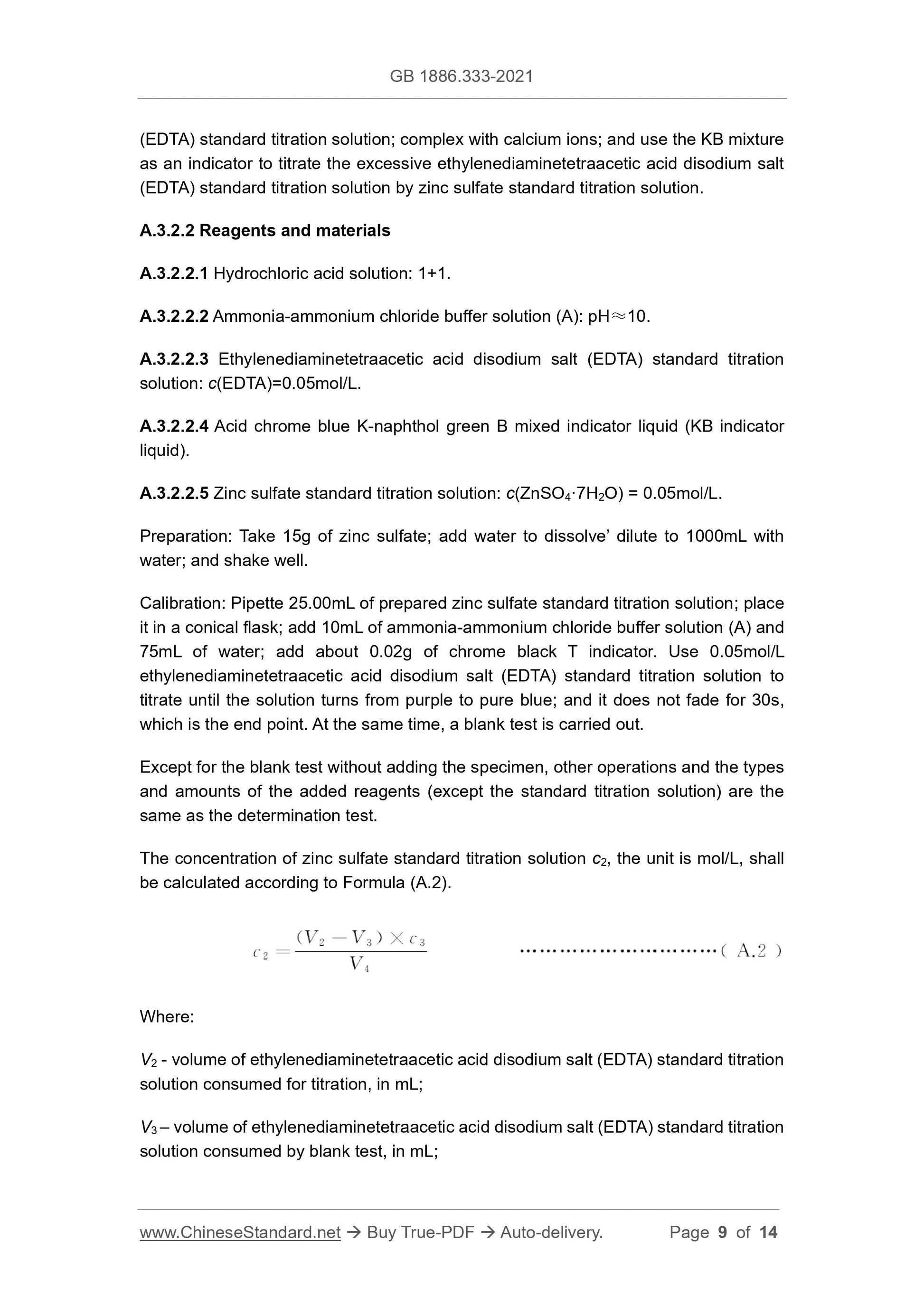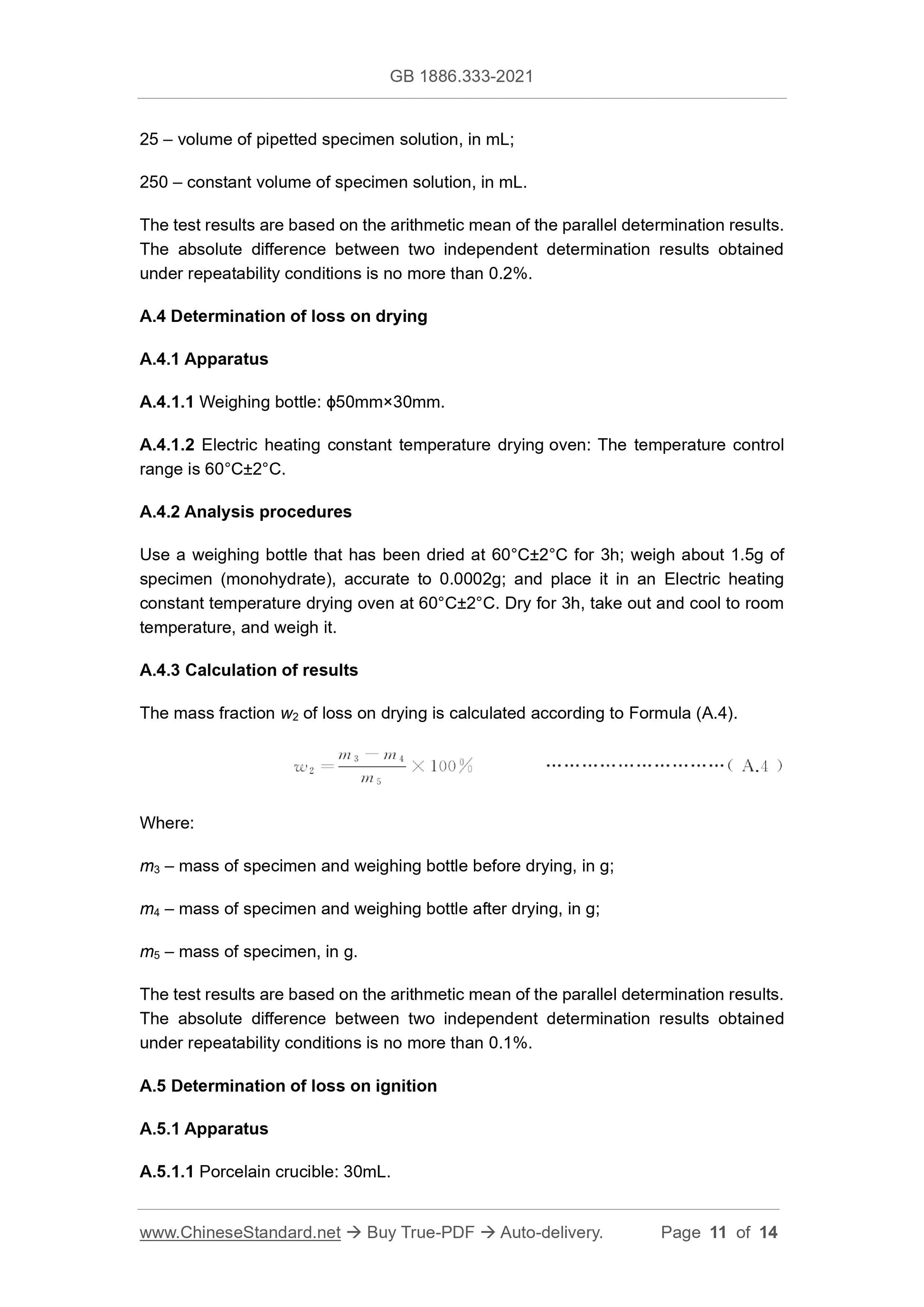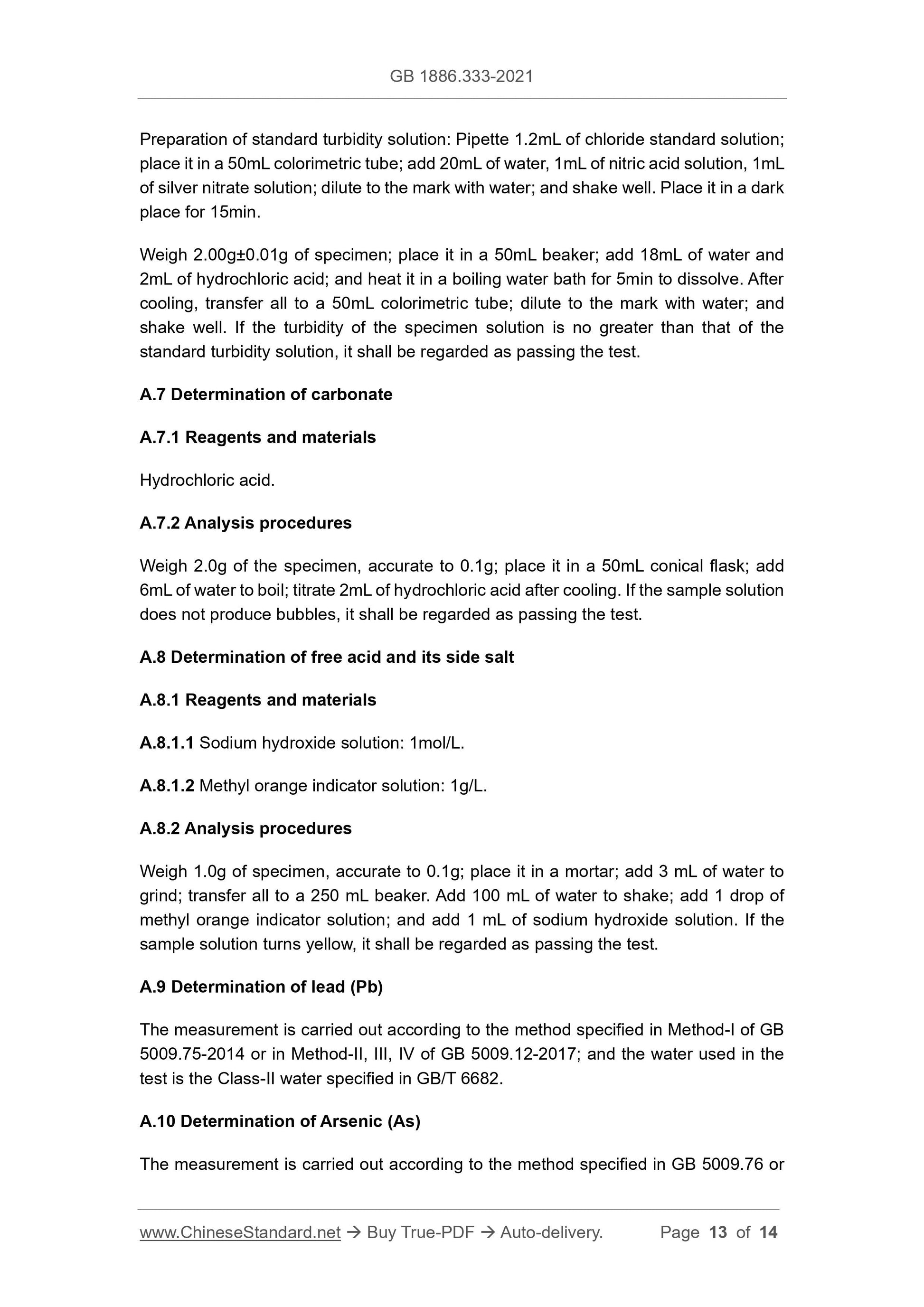1
/
of
7
PayPal, credit cards. Download editable-PDF & invoice in 1 second!
GB 1886.333-2021 English PDF (GB1886.333-2021)
GB 1886.333-2021 English PDF (GB1886.333-2021)
Regular price
$155.00 USD
Regular price
Sale price
$155.00 USD
Unit price
/
per
Shipping calculated at checkout.
Couldn't load pickup availability
Delivery: 3 seconds. Download true-PDF + Invoice.
Get QUOTATION in 1-minute: Click GB 1886.333-2021
Historical versions: GB 1886.333-2021
Preview True-PDF (Reload/Scroll if blank)
GB 1886.333-2021: National food safety standard - Food additives - Calcium dihydrogen phosphate
GB 1886.333-2021
GB
NATIONAL STANDARD OF THE
PEOPLE’S REPUBLIC OF CHINA
National Food Safety Standard -
Food Additives - Calcium Dihydrogen Phosphate
ISSUED ON: FEBRUARY 22, 2021
IMPLEMENTED ON: AUGUST 22, 2021
Issued by: National Health Commission of the People’s Republic of China;
State Administration for Market Regulation.
Table of Contents
Foreword ... 3
1 Scope ... 4
2 Molecular Formula and Relative Molecular Mass ... 4
3 Technical Requirements ... 4
Appendix A Inspection Methods ... 6
National Food Safety Standard -
Food Additives - Calcium Dihydrogen Phosphate
1 Scope
This Standard is applicable to the food additive of calcium dihydrogen phosphate
taking calcium hydrophosphate (or tricalcium phosphate, calcium hydroxide, calcium
carbonate) and food additive phosphoric acid (including wet-process phosphoric acid)
as raw materials.
2 Molecular Formula and Relative Molecular Mass
2.1 Molecular formula
Anhydrous calcium dihydrogen phosphate: Ca(H2PO4)2
Calcium dihydrogen phosphate monohydrate: Ca(H2PO4)2·H2O
2.2 Relative molecular mass
Anhydrous calcium dihydrogen phosphate: 234.05 (as per 2018 internal relative atomic
mass)
Calcium dihydrogen phosphate monohydrate: 252.07 (as per 2018 internal relative
atomic mass)
3 Technical Requirements
3.1 Sensory requirements
The sensory requirements shall comply with the provisions of Table 1.
Table 1 – Sensory Requirements
3.2 Physicochemical index
Appendix A
Inspection Methods
Caution: Some reagents used in this test method are toxic or corrosive, so
please be careful when operating! If necessary, perform it in a fume hood. If it
splashes on the skin, it shall be rinsed with water immediately, and the severe
cases shall be treated immediately.
A.1 General provisions
If no other requirements are specified, all the reagents and water used in this Standard
refer to the analytical reagents and Class-III water specified in GB/T 6682. If no other
requirements are specified, all the standard solution used in the test, standard solution
for determining the impurity, preparation and product shall be prepared according to
the provisions of GB/T 601, GB/T 602, GB/T 603.The solution used in the test refers
to the aqueous solution when the solvent is not specified.
A.2 Identification test
A.2.1 Reagents and materials
A.2.1.1 Nitric acid solution: 1+1.
A.2.1.2 Hydrochloric acid solution: 1+3.
A.2.1.3 Ammonium oxalate solution: 35g/L.
A.2.1.4 Ammonium molybdate solution: 60g/L, take 6g of ammonium molybdate
[(NH4)6MO7O24·4H2O] and dissolve it in 50mL of water, slowly add 50mL of nitric acid
solution while stirring, and store in a brown reagent bottle.
A.2.2 Identification method
A.2.2.1 Identification of calcium ions
Take about 0.1g of specimen; add 2mL of hydrochloric acid solution, 8mL of water;
heat to 40°C ~ 50°C; add 5mL of ammonium oxalate solution; and a white precipitate
is produced.
A.2.2.2 Identification of phosphate radical
Take about 0.1g of specimen; titrate nitric acid solution to dissolve the specimen; then
excess 1mL of nitric acid solution; heat to 40°C ~ 50°C; add 10mL of ammonium
molybdate solution; and produce yellow precipitate.
(EDTA) standard titration solution; complex with calcium ions; and use the KB mixture
as an indicator to titrate the excessive ethylenediaminetetraacetic acid disodium salt
(EDTA) standard titration solution by zinc sulfate standard titration solution.
A.3.2.2 Reagents and materials
A.3.2.2.1 Hydrochloric acid solution: 1+1.
A.3.2.2.2 Ammonia-ammonium chloride buffer solution (A): pH≈10.
A.3.2.2.3 Ethylenediaminetetraacetic acid disodium salt (EDTA) standard titration
solution: c(EDTA)=0.05mol/L.
A.3.2.2.4 Acid chrome blue K-naphthol green B mixed indicator liquid (KB indicator
liquid).
A.3.2.2.5 Zinc sulfate standard titration solution: c(ZnSO4·7H2O) = 0.05mol/L.
Preparation: Take 15g of zinc sulfate; add water to dissolve’ dilute to 1000mL with
water; and shake well.
Calibration: Pipette 25.00mL of prepared zinc sulfate standard titration solution; place
it in a conical flask; add 10mL of ammonia-ammonium chloride buffer solution (A) and
75mL of water; add about 0.02g of chrome black T indicator. Use 0.05mol/L
ethylenediaminetetraacetic acid disodium salt (EDTA) standard titration solution to
titrate until the solution turns from purple to pure blue; and it does not fade for 30s,
which is the end point. At the same time, a blank test is carried out.
Except for the blank test without adding the specimen, other operations and the types
and amounts of the added reagents (except the standard titration solution) are the
same as the determination test.
The concentration of zinc sulfate standard titration solution c2, the unit is mol/L, shall
be calculated according to Formula (A.2).
Where:
V2 - volume of ethylenediaminetetraacetic acid disodium salt (EDTA) standard titration
solution consumed for titration, in mL;
V3 – volume of ethylenediaminetetraacetic acid disodium salt (EDTA) standard titration
solution consumed by blank test, in mL;
25 – volume of pipetted specimen solution, in mL;
250 – constant volume of specimen solution, in mL.
The test results are based on the arithmetic mean of the parallel determination results.
The absolute difference between two independent determination results obtained
under repeatability conditions is no more than 0.2%.
A.4 Determination of loss on drying
A.4.1 Apparatus
A.4.1.1 Weighing bottle: ϕ50mm×30mm.
A.4.1.2 Electric heating constant temperature drying oven: The temperature control
range is 60°C±2°C.
A.4.2 Analysis procedures
Use a weighing bottle that has been dried at 60°C±2°C for 3h; weigh about 1.5g of
specimen (monohydrate), accurate to 0.0002g; and place it in an Electric heating
constant temperature drying oven at 60°C±2°C. Dry for 3h, take out and cool to room
temperature, and weigh it.
A.4.3 Calculation of results
The mass fraction w2 of loss on drying is calculated according to Formula (A.4).
Where:
m3 – mass of specimen and weighing bottle before drying, in g;
m4 – mass of specimen and weighing bottle after drying, in g;
m5 – mass of specimen, in g.
The test results are based on the arithmetic mean of the parallel determination results.
The absolute difference between two independent determination results obtained
under repeatability conditions is no more than 0.1%.
A.5 Determination of loss on ignition
A.5.1 Apparatus
A.5.1.1 Porcelain crucible: 30mL.
Preparation of standard turbidity solution: Pipette 1.2mL of chloride standard solution;
place it in a 50mL colorimetric tube; add 20mL of water, 1mL of nitric acid solution, 1mL
of silver nitrate solution; dilute to the mark with water; and shake well. Place it in a dark
place for 15min.
Weigh 2.00g±0.01g of specimen; place it in a 50mL beaker; add 18mL of water and
2mL of hydrochloric acid; and heat it in a boiling water bath for 5min to dissolve. After
cooling, transfer all to a 50mL colorimetric tube; dilute to the mark with water; and
shake well. If the turbidity of the specimen solution is no greater than that of the
standard turbidity solution, it shall be regarded as passing the test.
A.7 Determination of carbonate
A.7.1 Reagents and materials
Hydrochloric acid.
A.7.2 Analysis procedures
Weigh 2.0g of the specimen, accurate to 0.1g; place it in a 50mL conical flask; add
6mL of water to boil; titra...
Get QUOTATION in 1-minute: Click GB 1886.333-2021
Historical versions: GB 1886.333-2021
Preview True-PDF (Reload/Scroll if blank)
GB 1886.333-2021: National food safety standard - Food additives - Calcium dihydrogen phosphate
GB 1886.333-2021
GB
NATIONAL STANDARD OF THE
PEOPLE’S REPUBLIC OF CHINA
National Food Safety Standard -
Food Additives - Calcium Dihydrogen Phosphate
ISSUED ON: FEBRUARY 22, 2021
IMPLEMENTED ON: AUGUST 22, 2021
Issued by: National Health Commission of the People’s Republic of China;
State Administration for Market Regulation.
Table of Contents
Foreword ... 3
1 Scope ... 4
2 Molecular Formula and Relative Molecular Mass ... 4
3 Technical Requirements ... 4
Appendix A Inspection Methods ... 6
National Food Safety Standard -
Food Additives - Calcium Dihydrogen Phosphate
1 Scope
This Standard is applicable to the food additive of calcium dihydrogen phosphate
taking calcium hydrophosphate (or tricalcium phosphate, calcium hydroxide, calcium
carbonate) and food additive phosphoric acid (including wet-process phosphoric acid)
as raw materials.
2 Molecular Formula and Relative Molecular Mass
2.1 Molecular formula
Anhydrous calcium dihydrogen phosphate: Ca(H2PO4)2
Calcium dihydrogen phosphate monohydrate: Ca(H2PO4)2·H2O
2.2 Relative molecular mass
Anhydrous calcium dihydrogen phosphate: 234.05 (as per 2018 internal relative atomic
mass)
Calcium dihydrogen phosphate monohydrate: 252.07 (as per 2018 internal relative
atomic mass)
3 Technical Requirements
3.1 Sensory requirements
The sensory requirements shall comply with the provisions of Table 1.
Table 1 – Sensory Requirements
3.2 Physicochemical index
Appendix A
Inspection Methods
Caution: Some reagents used in this test method are toxic or corrosive, so
please be careful when operating! If necessary, perform it in a fume hood. If it
splashes on the skin, it shall be rinsed with water immediately, and the severe
cases shall be treated immediately.
A.1 General provisions
If no other requirements are specified, all the reagents and water used in this Standard
refer to the analytical reagents and Class-III water specified in GB/T 6682. If no other
requirements are specified, all the standard solution used in the test, standard solution
for determining the impurity, preparation and product shall be prepared according to
the provisions of GB/T 601, GB/T 602, GB/T 603.The solution used in the test refers
to the aqueous solution when the solvent is not specified.
A.2 Identification test
A.2.1 Reagents and materials
A.2.1.1 Nitric acid solution: 1+1.
A.2.1.2 Hydrochloric acid solution: 1+3.
A.2.1.3 Ammonium oxalate solution: 35g/L.
A.2.1.4 Ammonium molybdate solution: 60g/L, take 6g of ammonium molybdate
[(NH4)6MO7O24·4H2O] and dissolve it in 50mL of water, slowly add 50mL of nitric acid
solution while stirring, and store in a brown reagent bottle.
A.2.2 Identification method
A.2.2.1 Identification of calcium ions
Take about 0.1g of specimen; add 2mL of hydrochloric acid solution, 8mL of water;
heat to 40°C ~ 50°C; add 5mL of ammonium oxalate solution; and a white precipitate
is produced.
A.2.2.2 Identification of phosphate radical
Take about 0.1g of specimen; titrate nitric acid solution to dissolve the specimen; then
excess 1mL of nitric acid solution; heat to 40°C ~ 50°C; add 10mL of ammonium
molybdate solution; and produce yellow precipitate.
(EDTA) standard titration solution; complex with calcium ions; and use the KB mixture
as an indicator to titrate the excessive ethylenediaminetetraacetic acid disodium salt
(EDTA) standard titration solution by zinc sulfate standard titration solution.
A.3.2.2 Reagents and materials
A.3.2.2.1 Hydrochloric acid solution: 1+1.
A.3.2.2.2 Ammonia-ammonium chloride buffer solution (A): pH≈10.
A.3.2.2.3 Ethylenediaminetetraacetic acid disodium salt (EDTA) standard titration
solution: c(EDTA)=0.05mol/L.
A.3.2.2.4 Acid chrome blue K-naphthol green B mixed indicator liquid (KB indicator
liquid).
A.3.2.2.5 Zinc sulfate standard titration solution: c(ZnSO4·7H2O) = 0.05mol/L.
Preparation: Take 15g of zinc sulfate; add water to dissolve’ dilute to 1000mL with
water; and shake well.
Calibration: Pipette 25.00mL of prepared zinc sulfate standard titration solution; place
it in a conical flask; add 10mL of ammonia-ammonium chloride buffer solution (A) and
75mL of water; add about 0.02g of chrome black T indicator. Use 0.05mol/L
ethylenediaminetetraacetic acid disodium salt (EDTA) standard titration solution to
titrate until the solution turns from purple to pure blue; and it does not fade for 30s,
which is the end point. At the same time, a blank test is carried out.
Except for the blank test without adding the specimen, other operations and the types
and amounts of the added reagents (except the standard titration solution) are the
same as the determination test.
The concentration of zinc sulfate standard titration solution c2, the unit is mol/L, shall
be calculated according to Formula (A.2).
Where:
V2 - volume of ethylenediaminetetraacetic acid disodium salt (EDTA) standard titration
solution consumed for titration, in mL;
V3 – volume of ethylenediaminetetraacetic acid disodium salt (EDTA) standard titration
solution consumed by blank test, in mL;
25 – volume of pipetted specimen solution, in mL;
250 – constant volume of specimen solution, in mL.
The test results are based on the arithmetic mean of the parallel determination results.
The absolute difference between two independent determination results obtained
under repeatability conditions is no more than 0.2%.
A.4 Determination of loss on drying
A.4.1 Apparatus
A.4.1.1 Weighing bottle: ϕ50mm×30mm.
A.4.1.2 Electric heating constant temperature drying oven: The temperature control
range is 60°C±2°C.
A.4.2 Analysis procedures
Use a weighing bottle that has been dried at 60°C±2°C for 3h; weigh about 1.5g of
specimen (monohydrate), accurate to 0.0002g; and place it in an Electric heating
constant temperature drying oven at 60°C±2°C. Dry for 3h, take out and cool to room
temperature, and weigh it.
A.4.3 Calculation of results
The mass fraction w2 of loss on drying is calculated according to Formula (A.4).
Where:
m3 – mass of specimen and weighing bottle before drying, in g;
m4 – mass of specimen and weighing bottle after drying, in g;
m5 – mass of specimen, in g.
The test results are based on the arithmetic mean of the parallel determination results.
The absolute difference between two independent determination results obtained
under repeatability conditions is no more than 0.1%.
A.5 Determination of loss on ignition
A.5.1 Apparatus
A.5.1.1 Porcelain crucible: 30mL.
Preparation of standard turbidity solution: Pipette 1.2mL of chloride standard solution;
place it in a 50mL colorimetric tube; add 20mL of water, 1mL of nitric acid solution, 1mL
of silver nitrate solution; dilute to the mark with water; and shake well. Place it in a dark
place for 15min.
Weigh 2.00g±0.01g of specimen; place it in a 50mL beaker; add 18mL of water and
2mL of hydrochloric acid; and heat it in a boiling water bath for 5min to dissolve. After
cooling, transfer all to a 50mL colorimetric tube; dilute to the mark with water; and
shake well. If the turbidity of the specimen solution is no greater than that of the
standard turbidity solution, it shall be regarded as passing the test.
A.7 Determination of carbonate
A.7.1 Reagents and materials
Hydrochloric acid.
A.7.2 Analysis procedures
Weigh 2.0g of the specimen, accurate to 0.1g; place it in a 50mL conical flask; add
6mL of water to boil; titra...
Share
